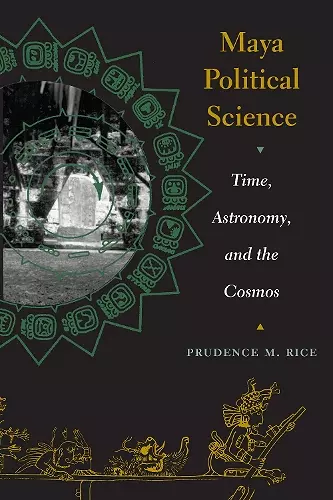Maya Political Science
Time, Astronomy, and the Cosmos
Format:Paperback
Publisher:University of Texas Press
Published:1st Nov '04
Currently unavailable, and unfortunately no date known when it will be back

"Just when you thought you had heard every possible model of Maya political organization, along comes Rice's book. Unsatisfied by "foreign" models (Mediterranean city-states, African segmentary states, Aegean peer-polities, Thai galactic polities, and Bali theater states), Rice draws on ethnohistoric, epigraphic, and archaeological data to develop a native Maya model in which the rotation of political seats of power conformed to calendar cycles of 256 years. This ambitious book is sure to provoke comments from the notoriously contentious field of Maya scholars." -- Joyce Marcus, Elman R. Service Professor of Cultural Evolution, University of Michigan
Rice builds a new model of Classic lowland Maya (AD 179–948) political organization and political geography.
How did the ancient Maya rule their world? Despite more than a century of archaeological investigation and glyphic decipherment, the nature of Maya political organization and political geography has remained an open question. Many debates have raged over models of centralization versus decentralization, superordinate and subordinate status—with far-flung analogies to emerging states in Europe, Asia, and Africa. But Prudence Rice asserts that neither the model of two giant "superpowers" nor that which postulates scores of small, weakly independent polities fits the accumulating body of material and cultural evidence.
In this groundbreaking book, Rice builds a new model of Classic lowland Maya (AD 179-948) political organization and political geography. Using the method of direct historical analogy, she integrates ethnohistoric and ethnographic knowledge of the Colonial-period and modern Maya with archaeological, epigraphic, and iconographic data from the ancient Maya. On this basis of cultural continuity, she constructs a convincing case that the fundamental ordering principles of Classic Maya geopolitical organization were the calendar (specifically a 256-year cycle of time known as the may) and the concept of quadripartition, or the division of the cosmos into four cardinal directions. Rice also examines this new model of geopolitical organization in the Preclassic and Postclassic periods and demonstrates that it offers fresh insights into the nature of rulership, ballgame ritual, and warfare among the Classic lowland Maya.
"Just when you thought you had heard every possible model of Maya political organization, along comes Rice's book. Unsatisfied by foreign models (Mediterranean city-states, African segmentary states, Aegean peer-polities, Thai galactic polities, and Bali theater states), Rice draws on ethnohistoric, epigraphic, and archaeological data to develop a native Maya model in which the rotation of political seats of power conformed to calendar cycles of 256 years. This ambitious book is sure to provoke comments from the notoriously contentious field of Maya scholars." Joyce Marcus, Elman R. Service Professor of Cultural Evolution, University of Michigan
ISBN: 9780292705692
Dimensions: unknown
Weight: 454g
376 pages